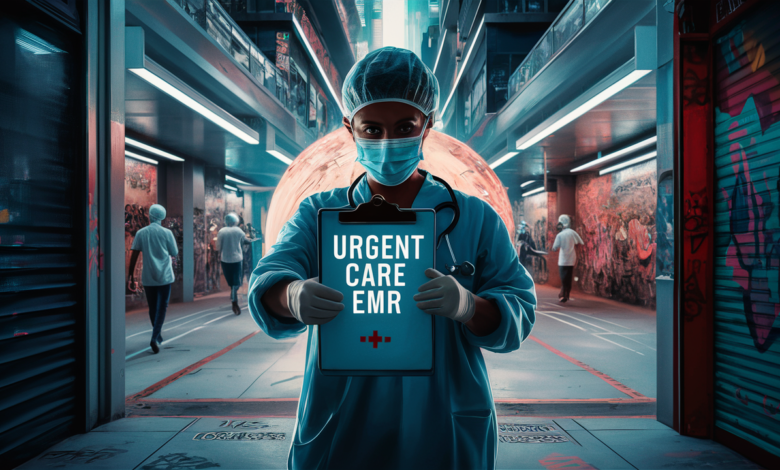Best Urgent Care EMR

Introduction
The dynamic landscape of healthcare demands efficiency, accuracy, and rapid adaptability. At the heart of this modern healthcare ecosystem lies the Electronic Medical Record (EMR) system, an indispensable tool that has revolutionized the way medical information is recorded, stored, and utilized. Urgent Care EMR systems, in particular, have become crucial in fast-paced environments where every second counts. These systems are tailored to meet the specific needs of urgent care settings, offering a myriad of benefits while also presenting unique challenges.
Understanding EMR in Urgent Care
Core Features of EMR Systems
Electronic Medical Record systems are designed to streamline the process of patient care by digitizing health records. They encompass a range of features, including patient history documentation, lab results, prescriptions, and real-time updates. For urgent care centers, these features must be robust, yet nimble enough to handle the high volume and fast turnover of patients typical in such settings.
Specific Needs of Urgent Care Centers
Urgent care centers operate differently from traditional medical practices. They are often the first point of contact for patients with non-life-threatening conditions that require immediate attention. As such, their EMR systems must cater to rapid patient intake, swift documentation, and seamless communication between healthcare providers. This ensures that patients receive timely and effective care.
Differences Between EMR in Urgent Care and Other Healthcare Settings
The primary difference between EMR systems in urgent care and other healthcare settings lies in the speed and efficiency required. In contrast to primary care, where patient visits are scheduled and records are often updated leisurely, urgent care EMRs must support a brisk, sometimes unpredictable workflow. This necessitates specialized features that cater to the high-pressure environment of urgent care facilities.
Benefits of EMR in Urgent Care
Enhanced Patient Care and Safety
One of the most significant advantages of EMR in urgent care is the enhancement of patient care and safety. By providing instant access to a patient’s medical history, allergies, and prior treatments, EMRs help clinicians make informed decisions swiftly. This reduces the likelihood of errors and ensures that patients receive the most appropriate care without unnecessary delays.
Streamlined Workflow and Efficiency
EMR systems greatly enhance the efficiency of urgent care centers. The digitization of patient records eliminates the need for cumbersome paper charts, reducing the time spent on administrative tasks. This allows healthcare providers to focus more on patient care, thereby improving overall productivity and reducing wait times.
Improved Documentation and Record-Keeping
Accurate documentation is critical in any medical setting, and EMRs excel in this regard. They provide a standardized format for record-keeping, ensuring that all necessary information is captured and easily accessible. This is particularly important in urgent care, where clinicians may need to review patient records quickly during follow-up visits.
Real-Time Data Access and Decision-Making
In urgent care, decisions often need to be made in real-time. EMRs support this by offering instant access to the latest patient data, including lab results and imaging reports. This real-time access to information is crucial for timely diagnosis and treatment, ultimately improving patient outcomes.
Challenges of Implementing EMR in Urgent Care
Cost Considerations
Implementing an EMR system can be a significant financial investment for urgent care centers, especially for smaller facilities with limited budgets. The cost of the software, hardware, and ongoing maintenance must be weighed against the potential benefits. Additionally, there may be hidden costs associated with training staff and integrating the system with existing technology.
Integration with Existing Systems
Another challenge is the integration of the new EMR system with existing systems. Many urgent care centers already use various software for billing, scheduling, and other administrative tasks. Ensuring that the new EMR system seamlessly integrates with these existing platforms is essential to avoid disruptions in service.
Staff Training and Adaptation
The successful implementation of an EMR system depends heavily on the ability of staff to adapt to the new technology. This often requires extensive training, which can be time-consuming and costly. Resistance to change is another common issue, as some staff members may be reluctant to move away from familiar paper-based processes.
Data Security and Compliance Issues
With the digitization of patient records comes the increased risk of data breaches. Urgent care centers must ensure that their EMR systems are compliant with all relevant data security regulations, such as the Health Insurance Portability and Accountability Act (HIPAA). This involves implementing robust security measures to protect patient information from unauthorized access.
Customization of EMR for Urgent Care
Tailoring Templates for Urgent Care Needs
One of the key advantages of modern EMR systems is their ability to be customized to meet the specific needs of different healthcare settings. For urgent care centers, this means creating templates that are tailored to common conditions and procedures. Custom templates streamline the documentation process, allowing clinicians to quickly and accurately record patient information.
Managing High Patient Volume with EMR
Urgent care centers often experience high patient volumes, particularly during peak hours. An EMR system that is optimized for urgent care can help manage this influx of patients by speeding up the intake process and ensuring that all necessary information is recorded efficiently. This helps to reduce wait times and improve patient satisfaction.
Adapting to the Fast-Paced Nature of Urgent Care
The fast-paced nature of urgent care requires an EMR system that can keep up with the demands of the environment. This means having features that allow for rapid documentation, quick access to patient records, and seamless communication between team members. An EMR system that is too slow or cumbersome can hinder the efficiency of the clinic.
Key Features of an Ideal Urgent Care EMR System
User-Friendly Interface
A user-friendly interface is essential for any EMR system, particularly in urgent care settings where time is of the essence. The interface should be intuitive and easy to navigate, allowing clinicians to quickly find the information they need without unnecessary clicks or steps.
Quick Access to Patient Information
In urgent care, every second counts. An ideal EMR system should provide quick access to patient information, including medical history, allergies, and medications. This ensures that clinicians can make informed decisions quickly and accurately.
Comprehensive Charting Tools
Comprehensive charting tools are a must-have feature for any EMR system. These tools allow clinicians to easily document patient visits, including symptoms, diagnoses, and treatment plans. The ability to create detailed, accurate charts is crucial for ensuring continuity of care and facilitating follow-up visits.
E-Prescribing Capabilities
E-prescribing is another important feature of an EMR system, allowing clinicians to send prescriptions directly to pharmacies electronically. This not only saves time but also reduces the risk of errors associated with handwritten prescriptions.
Integration with Diagnostic Tools
For urgent care centers, the ability to integrate the EMR system with diagnostic tools such as lab equipment and imaging devices is crucial. This integration allows for the seamless transfer of data, reducing the need for manual entry and ensuring that results are available in real-time.
Reporting and Analytics Features
Finally, an ideal EMR system should offer robust reporting and analytics features. These tools allow urgent care centers to track key performance indicators, identify trends, and make data-driven decisions to improve patient care and operational efficiency.
Selecting the Right EMR for Your Urgent Care
Assessing Your Urgent Care Center’s Needs
Before selecting an EMR system, it is important to assess the specific needs of your urgent care center. Consider factors such as patient volume, the types of services offered, and the skill level of your staff. Understanding your unique requirements will help you choose an EMR system that is the best fit for your clinic.
Evaluating EMR Vendors
Not all EMR systems are created equal, and choosing the right vendor is critical to the success of your implementation. When evaluating vendors, consider factors such as their experience in the urgent care industry, the quality of their customer support, and the scalability of their system.
Comparing Costs and ROI
While cost is an important consideration, it should not be the only factor in your decision. Consider the potential return on investment (ROI) that an EMR system can provide, such as improved efficiency, reduced errors, and enhanced patient care. A higher initial cost may be justified if the system offers significant long-term benefits.
Importance of Vendor Support and Training
Vendor support and training are critical components of a successful EMR implementation. Ensure that the vendor you choose offers comprehensive training programs and ongoing support to help your staff get up to speed with the new system. This will help to minimize disruptions and ensure a smooth transition.
The Role of EMR in Patient Satisfaction
Reducing Wait Times with EMR
One of the key factors in patient satisfaction is the amount of time spent waiting to be seen by a clinician. An efficient EMR system can help reduce wait times by streamlining the intake process and ensuring that patient information is readily available. This allows clinicians to see patients more quickly, improving overall satisfaction.
Enhancing Communication with Patients
EMR systems can also enhance communication with patients by providing them with access to their medical records, test results, and treatment plans through patient portals. This transparency helps to build trust and keeps patients informed about their care.
Ensuring Continuity of Care
Continuity of care is another important aspect of patient satisfaction. An EMR system ensures that all relevant information is recorded and easily accessible, allowing for seamless transitions between different healthcare providers. This continuity is especially important in urgent care, where patients may be seen by multiple clinicians over the course of their treatment.
Facilitating Follow-Up Care
EMR systems make it easier to schedule and manage follow-up care, ensuring that patients receive the ongoing treatment they need. Automated reminders and alerts can help ensure that patients don’t miss important appointments, further enhancing their overall experience.
Legal and Compliance Considerations
HIPAA Compliance in Urgent Care EMR
HIPAA compliance is a critical consideration for any EMR system. Urgent care centers must ensure that their EMR system meets all relevant privacy and security standards to protect patient information. This includes implementing encryption, access controls, and audit trails to monitor and secure data.
Ensuring Data Security and Privacy
In addition to HIPAA compliance, urgent care centers must take steps to ensure the security and privacy of patient data. This includes regular security audits, staff training on data protection, and the use of secure communication channels for sharing patient information.
Legal Risks and Liability Issues
The use of EMR systems also comes with potential legal risks and liability issues. For example, incomplete or inaccurate documentation can lead to legal disputes or malpractice claims. It is important to ensure that all staff members are trained on proper documentation practices and that the EMR system includes features to help mitigate these risks.
Documentation Standards and Audits
Regular audits of documentation standards are necessary to ensure that the EMR system is being used correctly and that all required information is being recorded. This helps to maintain the integrity of patient records and reduce the risk of legal issues.
The Impact of EMR on Urgent Care Staff
Reducing Administrative Burden
One of the main benefits of EMR systems is the reduction in administrative burden for urgent care staff. By automating many of the tasks associated with patient record-keeping, EMR systems free up time for clinicians to focus on patient care. This can lead to increased job satisfaction and reduced burnout.
Improving Staff Collaboration
EMR systems can also improve collaboration among staff members by providing a central repository for patient information. This allows clinicians, nurses, and administrative staff to work together more effectively, ensuring that all team members are on the same page when it comes to patient care.
Training and Skill Development
The implementation of an EMR system often requires staff to develop new skills, particularly in the use of technology. This can be a positive development, as it encourages continuous learning and professional growth. However, it is important to provide adequate training and support to ensure that staff members are confident in using the new system.
Managing Change Resistance
Resistance to change is a common challenge in any organization, and the implementation of an EMR system is no exception. It is important to address any concerns that staff members may have and to involve them in the planning and implementation process. This can help to reduce resistance and ensure a smoother transition.
Future Trends in Urgent Care EMR
The Rise of AI and Machine Learning
Artificial intelligence (AI) and machine learning are poised to play a significant role in the future of urgent care EMR systems. These technologies can help to analyze patient data, predict outcomes, and recommend treatment plans, ultimately improving patient care and efficiency.
Cloud-Based EMR Systems
Cloud-based EMR systems offer several advantages over traditional on-premise systems, including greater flexibility, scalability, and cost savings. As more urgent care centers adopt cloud-based solutions, we can expect to see continued innovation in this area.
Mobile Accessibility and Telemedicine Integration
With the rise of telemedicine, the ability to access EMR systems from mobile devices has become increasingly important. Mobile accessibility allows clinicians to review patient records, prescribe medications, and communicate with patients from anywhere, enhancing the overall patient experience.
Predictive Analytics and Data-Driven Care
Predictive analytics and data-driven care are emerging trends that have the potential to revolutionize urgent care. By analyzing large volumes of patient data, EMR systems can help clinicians identify patterns, predict outcomes, and make more informed decisions. This can lead to better patient care and more efficient operations.
Case Studies: Successful EMR Implementation in Urgent Care
Example 1: Small Urban Urgent Care Center
A small urban urgent care center successfully implemented an EMR system that was tailored to its specific needs. By customizing templates and workflows, the center was able to reduce patient wait times and improve overall efficiency. The implementation also led to better documentation and more accurate billing, resulting in increased revenue.
Example 2: Large Rural Urgent Care Network
A large rural urgent care network faced significant challenges in implementing an EMR system across multiple locations. However, by partnering with a vendor that offered comprehensive training and support, the network was able to overcome these challenges and successfully roll out the system. The EMR implementation led to improved communication between locations enhanced patient care, and better management of resources.
Lessons Learned from Successful Implementations
Successful EMR implementations share several common factors, including thorough planning, strong vendor support, and a focus on customization. By learning from these examples, other urgent care centers can avoid common pitfalls and achieve similar success.
Common Pitfalls in EMR Implementation and How to Avoid Them
Underestimating Training Needs
One of the most common pitfalls in EMR implementation is underestimating the amount of training required. It is important to provide comprehensive training for all staff members to ensure that they are comfortable with the new system. Ongoing training and support are also necessary to keep up with updates and changes.
Failing to Customize EMR to Fit Specific Needs
Another common mistake is failing to customize the EMR system to fit the specific needs of the urgent care center. Off-the-shelf solutions may not always meet the unique requirements of your clinic, so it is important to work with your vendor to tailor the system to your needs.
Overlooking Data Migration Issues
Data migration is a critical step in the EMR implementation process, and overlooking potential issues can lead to significant problems down the line. It is important to plan for data migration carefully, ensuring that all necessary data is transferred accurately and securely.
Neglecting to Plan for Ongoing Support
Finally, it is important to plan for ongoing support and maintenance of the EMR system. This includes regular updates, troubleshooting, and staff training to ensure that the system continues to function effectively and that any issues are addressed promptly.
Optimizing EMR for Better Outcomes
Continuous Improvement Strategies
To optimize the performance of your EMR system, it is important to implement continuous improvement strategies. This may involve regularly reviewing workflows, gathering feedback from staff and patients, and making adjustments as needed to enhance efficiency and patient care.
Monitoring EMR Performance
Regular monitoring of your EMR system’s performance is essential to identify any issues or areas for improvement. This can be done through regular audits, performance reports, and feedback from staff members. By staying proactive, you can ensure that your EMR system continues to meet the needs of your urgent care center.
Gathering Feedback from Staff and Patients
Feedback from staff and patients is invaluable in optimizing your EMR system. Staff




